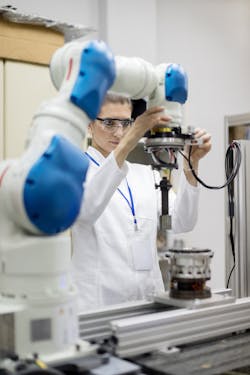A confluence of factors ranging from labor shortages and reshoring to greater demand for mass customization have led to a surge in the adoption of robotic technologies, with particularly high growth being seen for autonomous mobile robots (AMRs) and collaborative robots (cobots). AMRs have become increasingly popular in assembly and packaging operations where human labor is often lacking. In these cases, robotic arms or other peripheral devices attached to the tops of mobile carts can assist in loading and unloading goods from production lines. Likewise, cobots have proven popular for machine tending applications in the high-mix, low-volume (HMLV) space. Often, companies in the HMLV space are contract manufacturers who produce parts and components for larger industrial players, such as automotive manufacturers. As more of these large companies return to the U.S., HMLV manufacturers have seen a corresponding uptick in business, for which they do not always have the labor capacity to service.
To help address industry’s growing need for and interest in robots, the Advanced Robotics Manufacturing Institute (ARM) is funding two new robotics research projects at Rensselaer Polytechnic Institute’s School of Engineering. ARM is funded by the U.S Department of Defense (DoD) and leverages an ecosystem of more than 330 consortium members and partners across industry, academia, and government to support research that makes robotics, autonomy, and artificial intelligence more accessible to U.S. manufacturers. According to ARM, the projects being funded at Rensselaer focus on modernization priorities set by the DoD that also serve to strengthen U.S. manufacturing and empower workers.
The first project is led by John Wen, head of the department of electrical, computer, and systems engineering at Rensselaer. Its goal is to create a “high-speed, high-precision curvilinear robot tool trajectory based on a complex curved geometry using industrial robots with redundant degrees of freedom, to reduce or eliminate the need for manual tuning.” This technology can be applied in robotic spraying and deposition applications, ARM says.
Glenn Saunders, senior research engineer for the manufacturing innovation center at Rensselaer, will lead the second project. According to ARM, it “aims to develop fundamental technologies for robotic handling of energetic materials (i.e., explosives and self-reactive materials). It will demonstrate safety systems, robotic manipulation strategies, and designs that are immediately applicable to manufacturing…devices and products that use energetics.” Research teams from Schlumberger, Interface Technologies, and Fanuc America will also be partnering with Saunders for the project.
Further evidence of industry’s expanding interest in robotics can be seen in Universal Robots’ recent reporting of a record-breaking annual income of more than $300 million, up 41% from 2020. Commenting on the results, Kim Polvsen, president at Universal Robots, said, “Our growth is driven by several long-term trends, including workforce shortages and growing awareness of the contribution automation can make to productivity. As well as reaching new consumers, we see repeat business from manufacturers extending their use of cobots after seeing the impact of the technology.”
About the Author
David Miller
Former Senior Technical Writer

Leaders relevant to this article:
